Health Risk Assessment of Residents’ Exposure to Air Pollutants around the Sinpyeong–Jangrim Industrial Complex in Busan
Abstract
1. Introduction
2. Materials and Methods
2.1. Measurement Sites
2.2. Sampling and Analysis
2.3. Quality Assurance/Quality Control
2.4. Health Risk Assessment
2.5. Risk Prediction Using IDW
3. Results
3.1. Health Risk Assessment
3.2. Spatial Risk Distribution and Creation of a Risk Map Using IDW
4. Discussion
5. Conclusions
Author Contributions
Funding
Institutional Review Board Statement
Informed Consent Statement
Data Availability Statement
Conflicts of Interest
References
- National Institute of Chemical Safety. 2021 Chemical Emissions Survey Results; Korea Ministry of Environment: Sejong City, Republic of Korea, 2021.
- Yoon, M.R.; Jo, H.J.; Kim, G.B.; Chang, J.Y.; Lee, C.W.; Lee, B.E. Exposure to PAHs and VOCs in Residents near the SinpyeongJangrim Industrial Complex. J. Environ. Health Sci. 2021, 47, 131–143. [Google Scholar]
- Kamal, M.S.; Razzak, S.A.; Hossain, M.M. Caalytic oxidation of volatile organic compounds(VOCs)—A review. Atmos. Environ. 2016, 140, 117–134. [Google Scholar] [CrossRef]
- Oh, Y.J. Health Risk Assessment for Heavy Metal and VOCs of Residents in the Industrial Area; Soonchunhyang University: Asan-si, Republic of Korea, 2019. [Google Scholar]
- Shrestha, R.; Ban, S.; Devkota, S.; Sharama, S.; Joshi, R.; Tiwari, A.R.; Kim, H.Y.; Joshi, M.K. Technical trends in heavy metals removal from industrial wastewater: A review. J. Envrion. Chem. Eng. 2024, 9, 105688. [Google Scholar] [CrossRef]
- Fu, Z.; Xi, S. The Effects of Heavy Metals on Human Metabolism. Toxicol. Mech. Methods 2019, 30, 167–176. [Google Scholar] [CrossRef]
- National Institute of Food and Drug Safety (NIFDS). Development of Integrated Risk Assessment Methodology for Five Heavy Metals; NIFDS: Cheongju-si, Republic of Korea, 2020.
- Kim, S.Y.; Kwon, H.O. Overlapping Analysis of Air Dispersion Simulation for Odor Damage to Estimate the Effect Area in Busan and Ulsan, South Korea. J. Korean Soc. Hazard Mitig. 2018, 18, 83–91. [Google Scholar] [CrossRef][Green Version]
- Ji, H.S. Distribution and Characteristics of Heavy Metals in Soil Collected from School Playgrounds around the Sinpyeong-Jangrim Local Industrial Complex, Busan; Pusan National University: Busan, Republic of Korea, 2008. [Google Scholar]
- Bang, H.; Lee, M.R.; Kim, N.S.; Hwang, B.Y.; Kim, H.S.; Lee, S.S.; Kim, G.B.; Lee, B.E.; Yoon, M.R.; Kim, Y.B. The Health Status of Residents near Iksan Industrial Complex Based on Questionnaires. J. Environ. Health Sci. 2020, 46, 35–44. [Google Scholar]
- Lee, K.H.; Lee, S.W.; Ahn, R.M.; Kim, J.H.; Son, B.S. A study on the concentration of biomarkers for heavy metals and VOCs in the residents living in the vicinity of Gwangyang Industrial Complex in Korea. J. Odor Indoor Environ. 2019, 18, 228–235. [Google Scholar] [CrossRef]
- Statistics Korea. Status of Industrial Complex Construction in Busan Metropolitan City. Available online: https://www.data.go.kr/data/3076463/fileData.do (accessed on 8 June 2024).
- Sinpyeong Janglim Industrial Complex Management Corporation. Available online: http://www.sjbu.com/ (accessed on 8 June 2024).
- Lee, J.B. A Study on Satisfaction with Site Environment of Enterprises in Operation in Industrial Complexes-Focusing on Enterprises in Operation in Industrial Complexes Located in Busan Metropolitan City; Pusan National University: Busan, Republic of Korea, 2016. [Google Scholar]
- National Institute of Environmental Research (NIER). Environmental Health Assessment on the General Industrial Complex (VI); NIER-RP2016-298; NIER: Incheon, Republic of Korea, 2016.
- Busan Development Institute (BDI). Environmental Regeneration of Rain-Water Reservoir at Old-Passioned Industrial Park in Busan Metropolitan City; BDI: Busan, Republic of Korea, 2007.
- Busan Development Institute (BDI). Available online: https://bdi.re.kr/www/boardview/4/108 (accessed on 8 June 2024).
- Park, S.A.; Shin, H.J. Analysis of the Factors Influencing PM2.5 in Korea: Focusing on Seasonal Factors. Korea Environ. Policy Adm. Soc. 2017, 25, 227–248. [Google Scholar] [CrossRef]
- Myong, J.P. Health Effects of Particulate Matter. Korean Assoc. Intern. Med. 2016, 91, 107–113. [Google Scholar] [CrossRef]
- National Institute of Environmental Research (NIER). Air Pollution Monitoring Network Installation and Operation Guidelines; Korea Ministry of Environment: Sejong City, Republic of Korea, 2021.
- Peto, J.; Cuckle, H.; Doll, R.; Hermon, C.; Morgan, L.G. Respiratory Cancer Mortality of Welsh Nickel Refinery Workers; IARC Scientific Publications: Seoul, Republic of Korea, 1984; pp. 37–46. [Google Scholar]
- Brown, C.C.; Chu, K.C. Approaches to epidemiologic analysis of prospective and retrospective studies: Example of lung cancer and exposure to arsenic. In Proceedings of the Risk Assessment Proceedings SIMS Conference on Environmental Epidemiology, 1983; SIAM Publications: Alta, VT, USA, 1983. [Google Scholar]
- Brown, C.C.; Chu, K.C. Implications of the multistage theory of carcinogenesis applied to occupational arsenic exposure. J. Natl. Cancer Inst. 1983, 70, 455–463. [Google Scholar]
- Brown, C.C.; Chu, K.C. A new method for the analysis of cohort studies: Implications of the multistage theory of carcinogenesis applied to occupational arsenic exposure. Environ. Health Perspect. 1983, 50, 293–308. [Google Scholar] [CrossRef] [PubMed]
- Thun, M.J.; Schnorr, T.M.; Smith, A.B.; Halperin, W.E.; Lemen, R.A. Mortality among a cohort of U.S. cadmium production workers-an update. J. Natl. Cancer Inst. 1985, 74, 325–333. [Google Scholar] [PubMed]
- Malsch, P.A.; Proctor, D.M.; Finley, B.L. Estimation of a chromium inhalation reference concentration using the benchmark dose method: A case study. Regul. Y Toxicol. Pharmacol. 1994, 20, 58–823. [Google Scholar] [CrossRef] [PubMed]
- Rothman, N.; Li, G.L.; Dosemeci, M.; Bechtold, W.E.; Marti, G.E.; Wang, Y.Z.; Linet, M.; Xi, L.Q.; Lu, W.; Smith, M.T.; et al. Hematotoxicity among Chinese workers heavily exposed to benzene. Am. J. Ind. Med. 1996, 29, 236–246. [Google Scholar] [CrossRef]
- Roels, H.A.; Ghyselen, P.; Buchet, J.P.; Ceulemenas, E.; Lauwerys, R.R. Assessment of the permissible exposure level to manganese in workers exposed to manganese dioxide dust. Br. J. Ind. Med. 1992, 49, 25–34. [Google Scholar] [CrossRef]
- US Environmental Protection Agency (US EPA). Drinking Water Criteria Document for Manganese (External Review Draft); US EPA: Washington, DC, USA, 1998.
- Mancuso, T.F. Consideration of chromium as an industrial carcinogens. In Proceedings of the International Conference on Heavy Metals in the Environment, Toronto, ON, Canada, 27–31 October 1995; pp. 343–356. [Google Scholar]
- US Environmental Protection Agency (US EPA). Carcinogenic Effects of Benzene: An Update; US EPA: Washington, DC, USA, 1998.
- US Environmental Protection Agency (US EPA). Toxicological Review Of Toluene in Support of Summary Information on the Integrated Risk Information System (IRIS); US EPA: Washington, DC, USA, 2005.
- Andrew, F.D.; Buschbom, R.L.; Cannon, W.C. Miler RA. Montgomery LF, Phelps PW, Sikev, RM. Teratologic Assessment of Ethylbenzene and 2-Ethoxyethanol; Battle Pacific Northwest Laboratory: Richland, WA, USA, 1981.
- Korsak, Z.; Wišniewska-Knypl, J.; Swiercz, R. Toxic effects of subchronic combined exposure to n-butyl alcohol and m-xylene in rats. Int. J. Occup. Med. Envrion. Health 1994, 7, 155–166. [Google Scholar]
- Mutti, A.; Mazzucchi, A.; Rustichelli, P.; Frigeri, G.; Arfini, I.; Franchini, I. Exposure-effect and exposure-response relationships between occupational exposure to styrene and neuropsychological functions. Am. J. Ind. Med. 1984, 5, 275–286. [Google Scholar] [CrossRef]
- Statistics Korea. Simple Life Table (by 5 Years Old). Available online: https://kosis.kr/statHtml/statHtml.do?orgId=101&tblId=DT_1B41&conn_path=I2 (accessed on 26 April 2024).
- Jeon, J.M.; Kang, B.W.; Lee, H.S.; Lee, C.M. Health Risk Assessment of Heavy Metals in PM2.5 in Industrial Area. J. Environ. Health Sci. 2010, 36, 294–305. [Google Scholar] [CrossRef]
- National Institute of Environmental Research (NIER). Korean Exposure Factors Handbook; Korea Ministry of Environment: Sejong City, Republic of Korea, 2019.
- Kang, B.W.; Han, J.S.; Lee, M.D.; Lee, H.S.; Kim, J.H.; Son, E.S.; Baek, S.O. Concentration Characteristics of Airborne Hexavalent Chromium in the Industrial Area. J. Korean Soc. Atmos. Environ. 2009, 25, 179–187. [Google Scholar] [CrossRef][Green Version]
- Ministry of Environment (MOE). Guidelines for Review and Evaluation of Health Impact Items. Available online: https://www.law.go.kr/LSW/admRulInfoP.do?admRulSeq=2000000022373&lsId=2036128&chrClsCd=010202 (accessed on 10 June 2024).
- National Institute of Environmental Research (NIER). Regulations on Specific Methods of Chemical Risk Assessment. Available online: https://www.law.go.kr/%ED%96%89%EC%A0%95%EA%B7%9C%EC%B9%99/%ED%99%94%ED%95%99%EB%AC%BC%EC%A7%88%EC%9C%84%ED%95%B4%EC%84%B1%ED%8F%89%EA%B0%80%EC%9D%98%EA%B5%AC%EC%B2%B4%EC%A0%81%EB%B0%A9%EB%B2%95%EB%93%B1%EC%97%90%EA%B4%80%ED%95%9C%EA%B7%9C%EC%A0%95 (accessed on 26 April 2024).
- Yu, J.S.; Waseem, M.; Shin, J.Y.; Kim, T.W. Evaluation of Extended Inverse Distance Weighting Method for Constructing a Flow Duration Curve at Ungauged Basin. J. Korean Soc. Hazard Mitig. 2015, 15, 329–337. [Google Scholar] [CrossRef]
- Maleika, W. Inverse distance weighting method optimization in the process of digital terrain model creation based on data collected from a multibeam echosounder. Appl. Geomat. 2020, 12, 397–407. [Google Scholar] [CrossRef]
- Quantum Geographic Information System (QGIS). Available online: https://www.qgis.org/en/site/ (accessed on 5 June 2024).
- National Institute of Environmental Research (NIER). Monthly Report of Air Quality; NIER: Sejong City, Republic of Korea, 2023.
- National Institute of Environmental Research (NIER). Environmental Pollutant Exposure and Monitoring of Health Effects on People Living Near Industrial Areas in Ulsan (Ulsan, 2nd Year of 2nd Step Study); NIER: Sejong City, Republic of Korea, 2013.
- National Institute of Environmental Research (NIER). Annual Report of Air Quality in Korea 2022; NIER: Sejong City, Republic of Korea, 2023.
- Choi, S.H.; Choi, S.W.; Kim, D.Y.; Cha, Y.W.; Park, S.W.; Lee, S.I.; Yoo, E.C. Evaluation of Health Risk from Concentrations of Heavy Metal in PM10 and PM2.5 particles at Sasang Industrial Complex of Busan, Korea. J. Environ. Anal. Health Toxicol. 2021, 24, 133–148. [Google Scholar] [CrossRef]
- Jang, J.Y. Characteristics of PM2.5 Mass Concentration & Chemical Compositions in Busan Metropolitan City; Kyungsung University: Busan, Republic of Korea, 2016. [Google Scholar]
- Ministry of Environment (MOE). Manual for Adding and Evaluating Health Impact Items to Prepare Hygiene and Public Health Items in the Environmental Impact Assessment Report; MOE: Sejong City, Republic of Korea, 2021.
- Kim, H.J.; Im, J.Y.; Yun, J.H.; Lee, J.H.; Jeon, J.H.; Lee, C.S. A Study on the Characteristics of Chemicals in Majour Industrial Complexes. J. Environ. Health Sci. 2018, 44, 515–523. [Google Scholar]
- Cheong, J.P.; You, S.J. Characteristics and Identification of Ambient VOCs Sources in Busan Industrial Area. J. Korean Soc. Environ. Eng. 2011, 33, 644–655. [Google Scholar] [CrossRef]
- Kwon, J.Y.; Hong, Y.S. Chronic Exposure to Arsenic and the Effects on Human Health. J. Environ. Health Sci. 2023, 49, 237–246. [Google Scholar] [CrossRef]
- National Cancer Information Center (NCIC). Benzene-Carcinogenic Factor Report; NCIC: Goyang-si, Republic of Korea, 2022.
- National Institute of Environmental Research (NIER). Available online: https://icis.me.go.kr/search/searchType6.do (accessed on 13 June 2024).

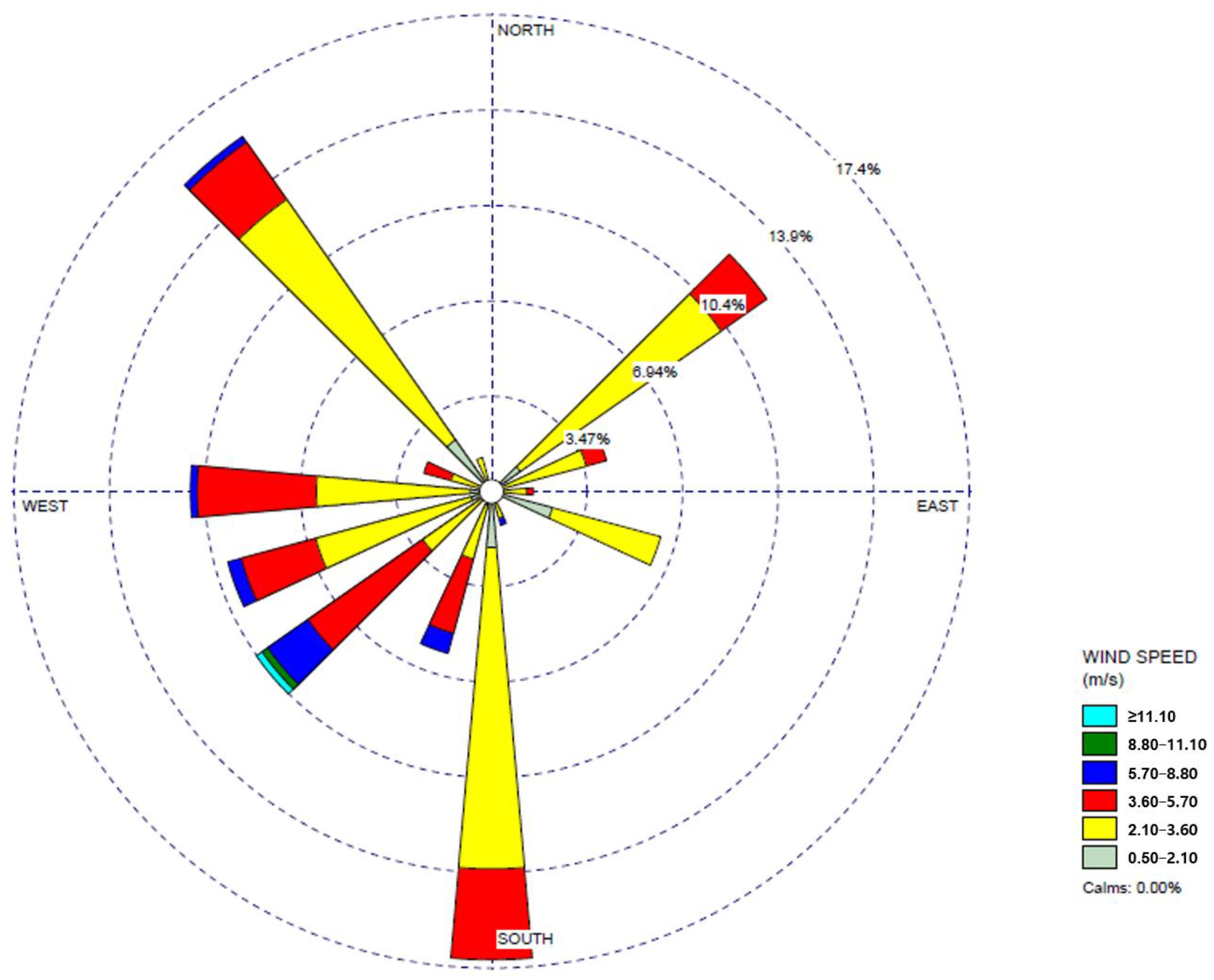


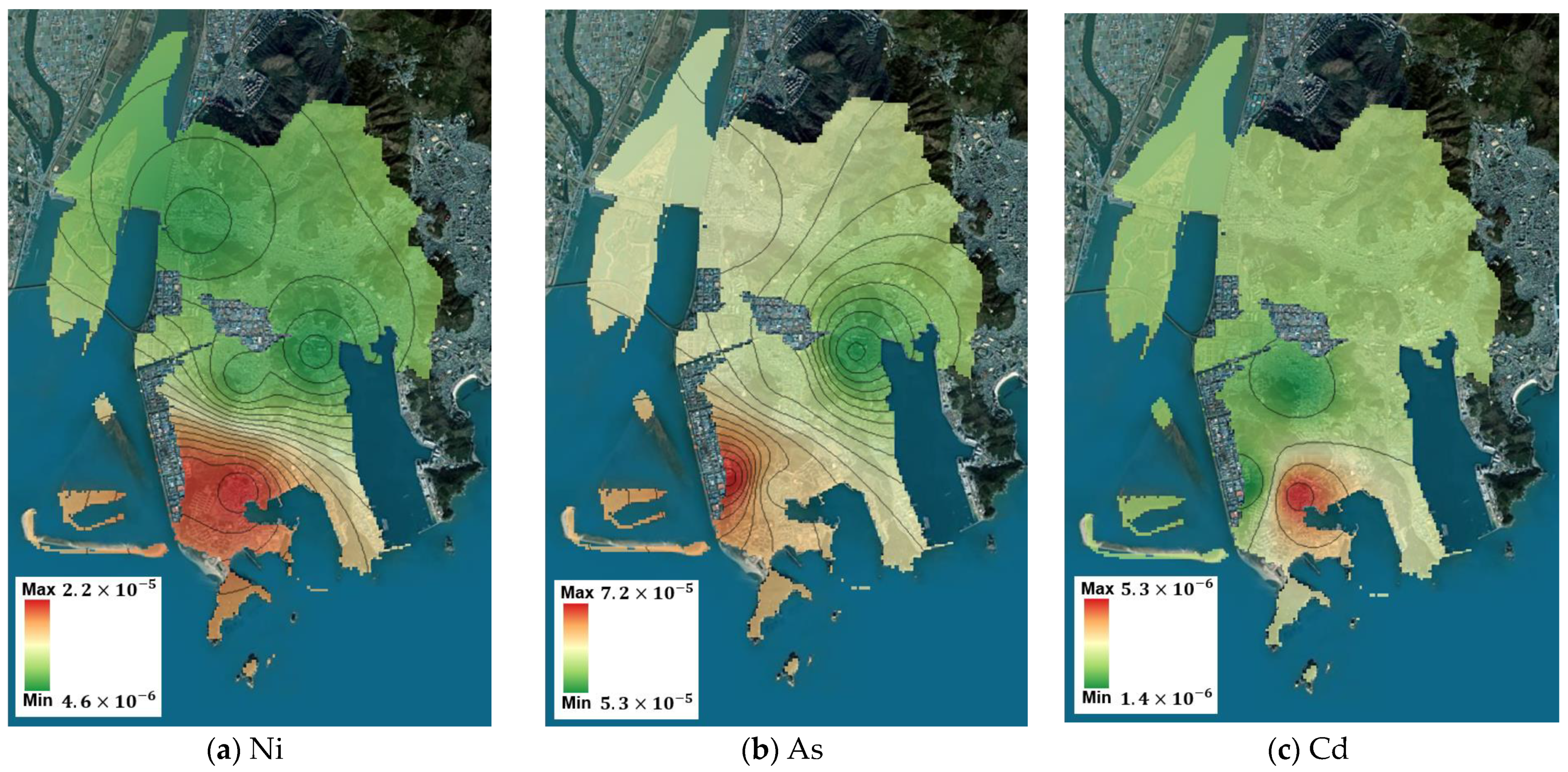
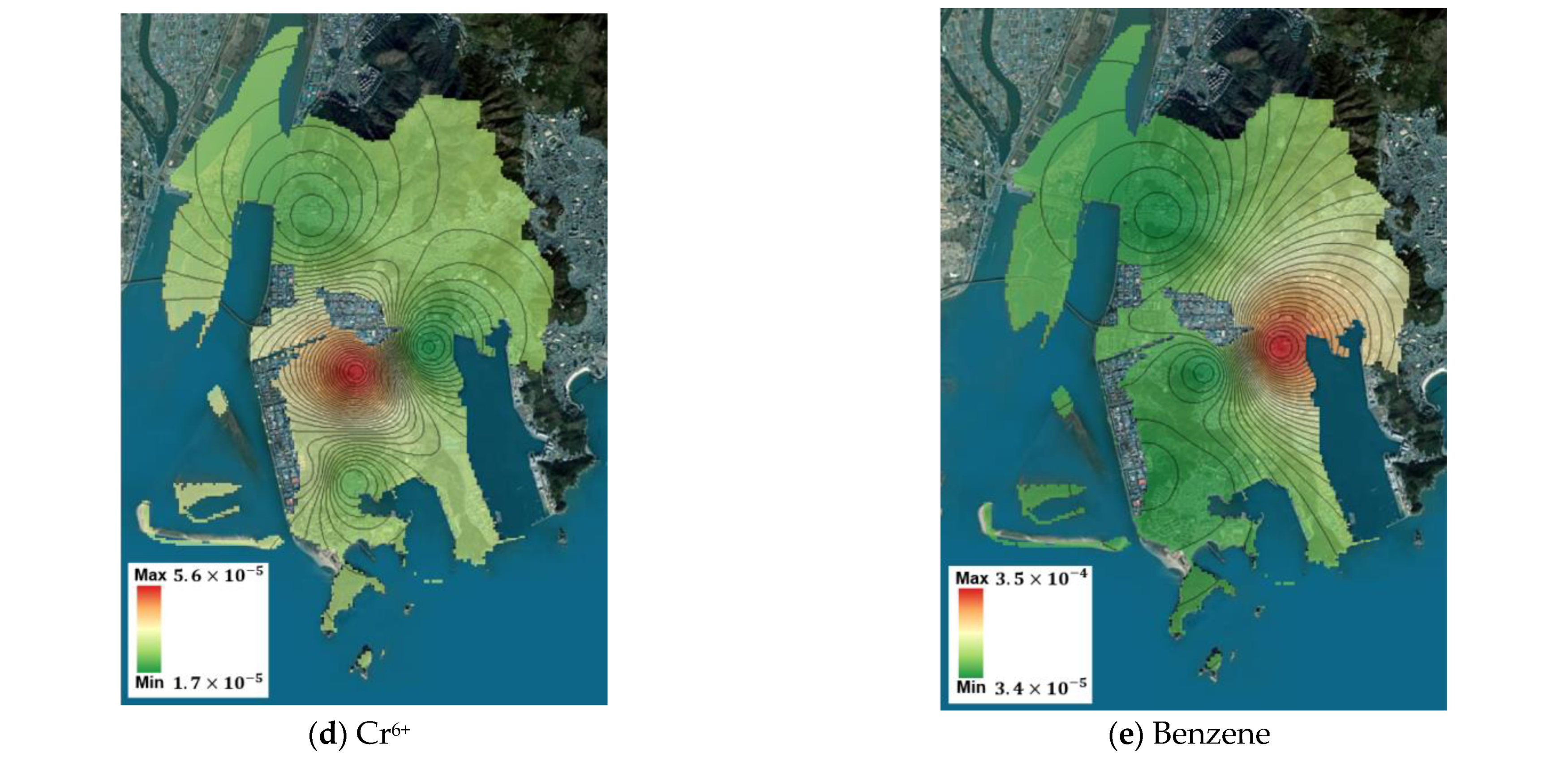
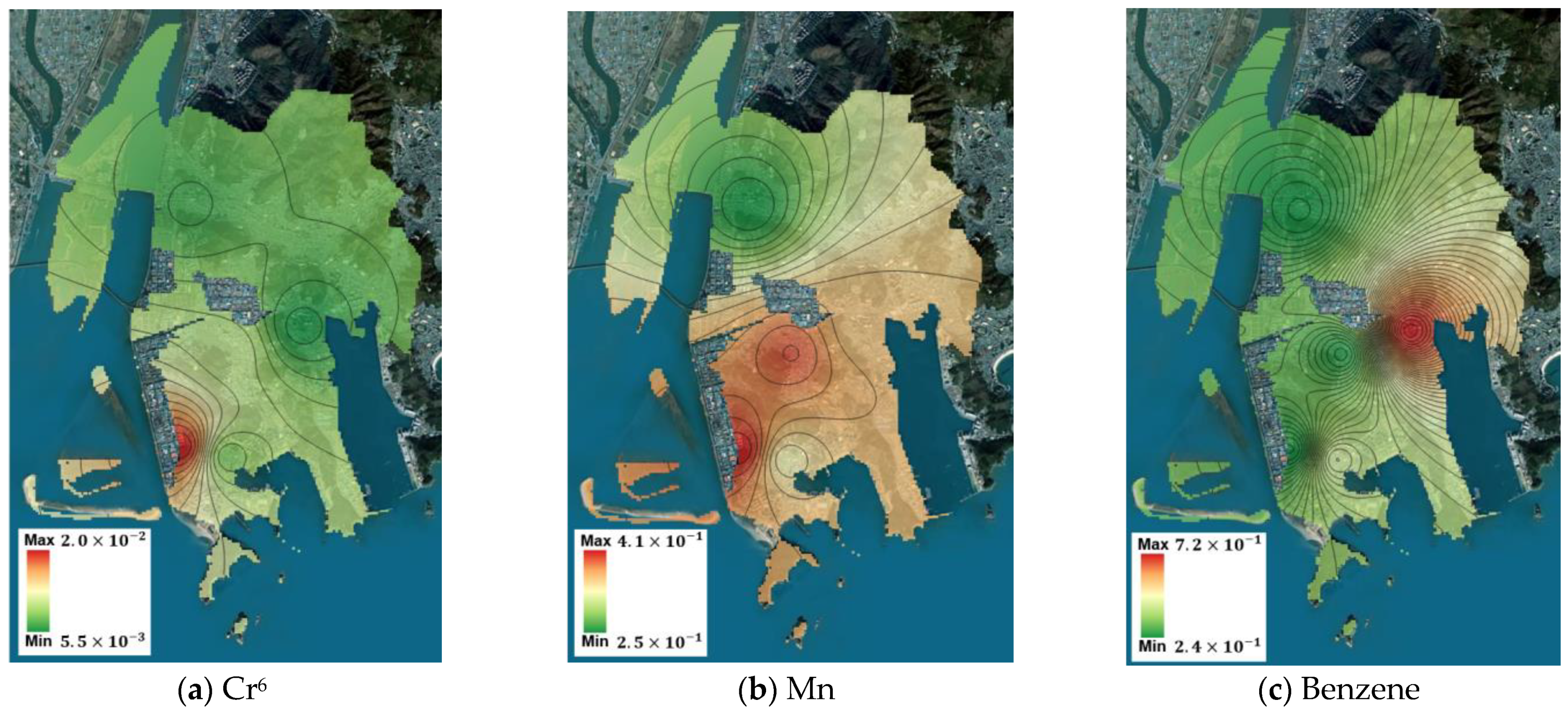
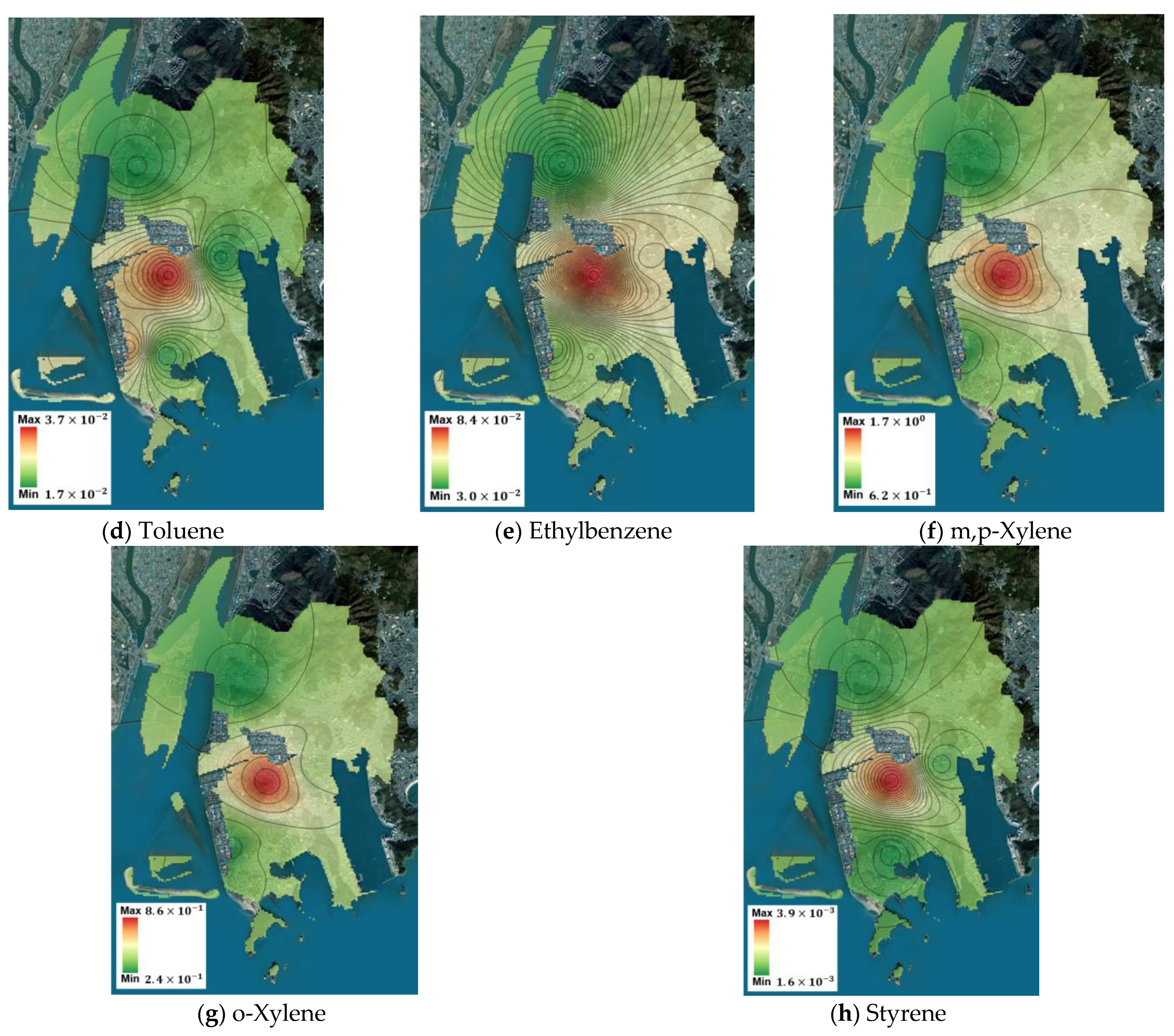

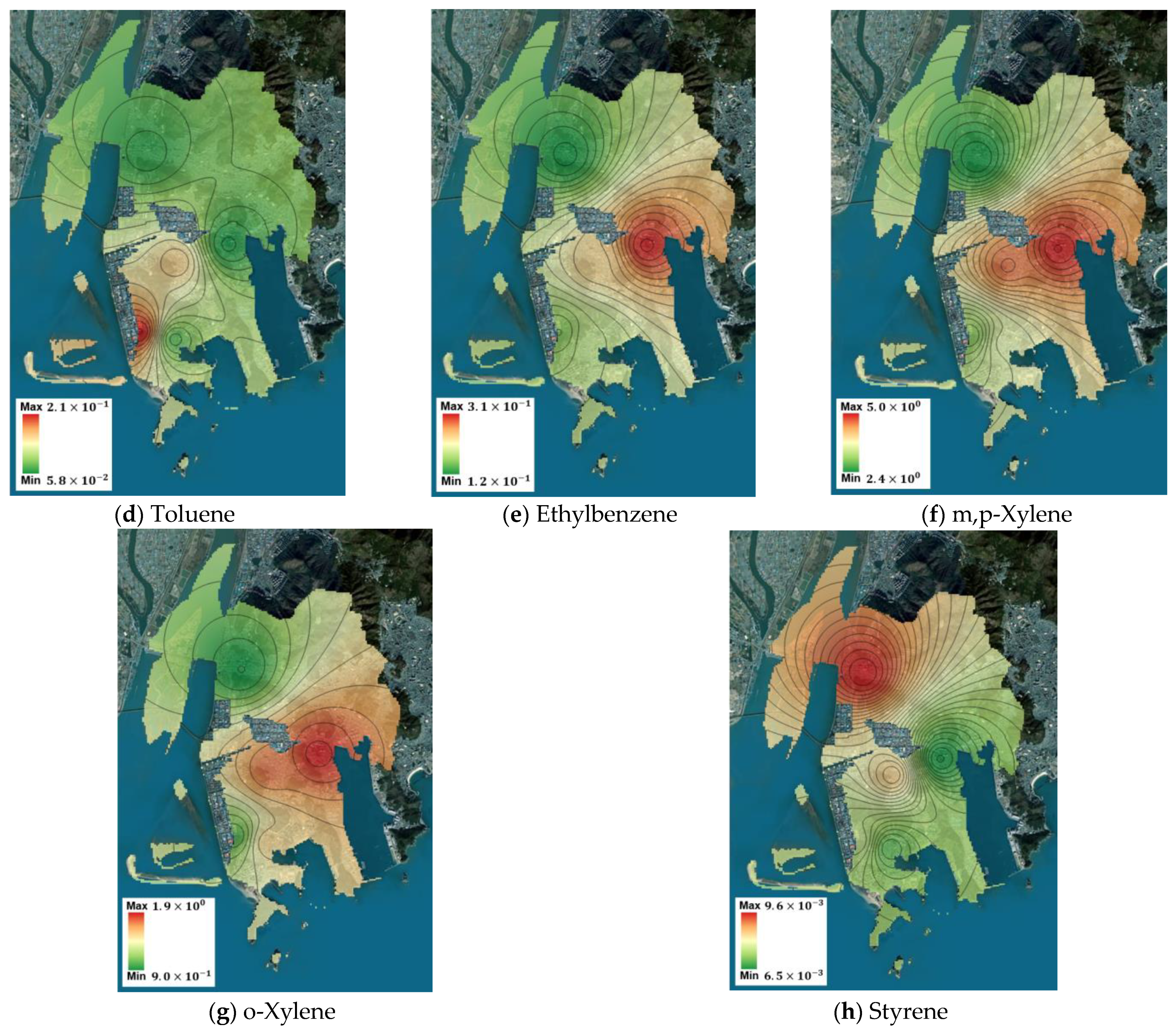
| Pollutants | MDL a | RSD b (%) | |
|---|---|---|---|
| Heavy metals (ng/m3) | Ni | 4.07 | 0.28 |
| As | 1.37 | 0.31 | |
| Cd | 7.69 | 1.13 | |
| Cr | 1.12 | 0.10 | |
| Mn | 6.53 | 0.38 | |
| VOCs (μg/m3) | Benzene | 1.7 | 0.54 |
| Toluene | 5.3 | 1.69 | |
| Ethylbenzene | 5.3 | 1.69 | |
| m,p-Xylene | 9.1 | 2.90 | |
| o-Xylene | 5.8 | 1.85 | |
| Styrene | 2.9 | 0.92 | |
| Pollutants | Carcinogenic Class | UR a ((μg/m3)−1) | Extrapolation Method | Tumor Type | References | |
|---|---|---|---|---|---|---|
| Heavy Metals | Ni | A | 2.4 × 10−4 | Additive and multiplicative | Lung cancer | [21] |
| As | A | 4.3 × 10−3 | Absolute-risk linear model | Lung cancer | [22,23,24] | |
| Cd | B1 | 1.8 × 10−3 | Only first affected by exposure, extra risk | Lung, trachea, bronchus cancer | [25] | |
| Cr6+ | A | 1.2 × 10−2 | Multistage, extra risk | Lung cancer | [26] | |
| VOCs | Benzene | A | 2.2 × 10−6 | Low-dose linearity using maximum likelihood estimates | Leukemia | [27] |
| Pollutants | Non-Carcinogenic Health Effect | RfC a (mg/m3) | NOAEL b/ LOAEL c (mg/m3) | UF d | MF e | References | |
|---|---|---|---|---|---|---|---|
| Heavy Metals | Mn | Impairment of neurobehavioral function | 5.0 × 10−5 | 5.0 × 10−2 | 1000 | 1 | [28,29] |
| Cr6+ | Lactate dehydrogenase in bronchioalveolar lavage fluid | 1.0 × 10−4 | 3.4 × 10−2 | 300 | 1 | [30] | |
| VOCs | Benzene | Decreased lymphocyte count | 3.0 × 10−2 | 8.2 × 100 | 300 | 1 | [31] |
| Toluene | Neurological effects in occupationally exposed workers | 5.0 × 100 | 4.6 × 101 | 10 | - | [32] | |
| Ethylbenzene | Developmental toxicity | 1.0 × 100 | 4.3 × 102 | 300 | 1 | [33] | |
| m,p-Xylene | Impaired motor coordination (decreased rotarod performance) | 1.0 × 10−1 | 3.9 × 101 | 300 | 1 | [34] | |
| o-Xylene | Impaired motor coordination (decreased rotarod performance) | 1.0 × 10−1 | 3.9 × 101 | 300 | 1 | [34] | |
| Styrene | CNC effects | 1.0 × 100 | 3.4 × 101 | 30 | 1 | [35] | |
| Variables | Mean ± SD a | RME b | References |
|---|---|---|---|
| Body weight (kg) | 64.5 ± 12.65 | 64.5 | [38] |
| Inhalation rate (m3/day) | 14.62 ± 3.19 | 18.97 | [38] |
| Exposure duration (day) | 300 ± 19 | 330 | [37] |
| Lifetime (year) | 82.7 | 82.7 | [36] |
| Heavy Metals | Measurement Sites | Mean ± SD a | RME b | p-Value c | VOCs | Measurement Sites | Mean ± SD a | RME b | p-Value c |
|---|---|---|---|---|---|---|---|---|---|
| Ni | A | 7.85 ± 17.26 | 32.37 | p > 0.05 | Benzene | A | 3.42 ± 4.29 | 6.75 | p > 0.05 |
| B | 9.51 ± 26.89 | 26.94 | B | 10.32 ± 27.82 | 69.31 | ||||
| C | 8.93 ± 18.33 | 37.17 | C | 3.69 ± 4.10 | 6.83 | ||||
| D | 23.34 ± 73.44 | 121.08 | D | 3.43 ± 2.62 | 7.99 | ||||
| E | 18.18 ± 40.74 | 126.90 | E | 6.35 ± 19.37 | 9.95 | ||||
| As | A | 8.08 ± 6.03 | 20.25 | p > 0.05 | Toluene | A | 34.21 ± 31.04 | 93.72 | p < 0.05 |
| B | 6.93 ± 5.10 | 17.12 | B | 34.01 ± 36.49 | 82.38 | ||||
| C | 8.76 ± 6.10 | 19.71 | C | 75.78 ± 86.98 | 224.47 | ||||
| D | 9.17 ± 7.08 | 23.45 | D | 63.86 ± 99.31 | 300.89 | ||||
| E | 9.40 ± 7.66 | 20.92 | E | 36.85 ± 43.10 | 108.70 | ||||
| Cd | A | 1.27 ± 0.54 | 2.12 | p < 0.05 | Ethylbenzene | A | 10.57 ± 90.36 | 28.83 | p > 0.05 |
| B | 1.21 ± 0.42 | 2.13 | B | 20.69 ± 32.58 | 77.31 | ||||
| C | 1.10 ± 0.36 | 1.07 | C | 29.50 ± 97.81 | 58.72 | ||||
| D | 1.09 ± 0.33 | 1.08 | D | 14.56 ± 13.55 | 39.48 | ||||
| E | 1.70 ± 1.13 | 4.13 | E | 16.24 ± 18.40 | 46.87 | ||||
| Cr | A | 13.10 ± 14.31 | 3.13 | p < 0.05 | m,p-Xylene | A | 21.96 ± 40.27 | 59.65 | p > 0.05 |
| B | 10.62 ± 12.43 | 24.29 | B | 40.31 ± 65.96 | 123.93 | ||||
| C | 20.31 ± 28.33 | 80.92 | C | 59.73 ± 244.61 | 114.35 | ||||
| D | 38.19 ± 112.52 | 48.96 | D | 24.96 ± 23.49 | 74.52 | ||||
| E | 15.82 ± 28.35 | 33.38 | E | 31.95 ± 31.66 | 90.06 | ||||
| Mn | A | 19.30 ± 19.28 | 46.55 | p > 0.05 | o-Xylene | A | 8.55 ± 11.17 | 22.22 | p > 0.05 |
| B | 27.15 ± 19.37 | 73.55 | B | 16.06 ± 22.05 | 47.93 | ||||
| C | 29.98 ± 42.00 | 126.31 | C | 30.35 ± 155.45 | 44.09 | ||||
| D | 31.22 ± 29.01 | 77.28 | D | 9.80 ± 8.32 | 25.35 | ||||
| E | 25.53 ± 48.83 | 121.38 | E | 14.34 ± 12.99 | 38.55 | ||||
| - | Styrene | A | 0.63 ± 0.81 | 2.42 | p > 0.05 | ||||
| B | 0.70 ± 0.67 | 1.64 | |||||||
| C | 1.40 ± 5.28 | 2.14 | |||||||
| D | 0.68 ± 0.86 | 1.94 | |||||||
| E | 0.59 ± 0.86 | 1.74 | |||||||
| Pollutants | Measurement Sites | ||||||||||
|---|---|---|---|---|---|---|---|---|---|---|---|
| A | B | C | D | E | |||||||
| CTE | RME | CTE | RME | CTE | RME | CTE | RME | CTE | RME | ||
| Heavy metals | Ni | 9.5 × 10−7 | 5.6 × 10−6 | 1.1 × 10−6 | 4.6 × 10−6 | 1.1 × 10−6 | 6.4 × 10−6 | 2.8 × 10−6 | 2.1 × 10−5 | 2.2 × 10−6 | 2.2 × 10−5 |
| As | 1.7 × 10−5 | 6.2 × 10−5 | 1.5 × 10−5 | 5.3 × 10−5 | 1.9 × 10−5 | 6.1 × 10−5 | 2.0 × 10−5 | 7.2 × 10−5 | 2.0 × 10−5 | 6.5 × 10−5 | |
| Cd | 1.2 × 10−6 | 2.7 × 10−6 | 1.1 × 10−6 | 2.7 × 10−6 | 1.0 × 10−6 | 1.4 × 10−6 | 9.8 × 10−7 | 1.4 × 10−6 | 1.5 × 10−6 | 5.3 × 10−6 | |
| Cr6+ | 6.3 × 10−6 | 2.1 × 10−5 | 5.1 × 10−6 | 1.7 × 10−6 | 9.8 × 10−6 | 5.6 × 10−5 | 1.8 × 10−5 | 3.4 × 10−5 | 7.6 × 10−6 | 2.3 × 10−5 | |
| VOCs | Benzene | 1.2 × 10−6 | 3.4 × 10−5 | 3.6 × 10−5 | 3.5 × 10−4 | 1.3 × 10−5 | 3.4 × 10−5 | 1.2 × 10−5 | 4.0 × 10−5 | 2.2 × 10−5 | 5.0 × 10−5 |
| Pollutants | Measurement Sites | ||||||||||
|---|---|---|---|---|---|---|---|---|---|---|---|
| A | B | C | D | E | |||||||
| CTE | RME | CTE | RME | CTE | RME | CTE | RME | CTE | RME | ||
| Heavy metals | Cr6+ | 6.8 × 10−3 | 2.3 × 10−2 | 5.5 × 10−3 | 1.8 × 10−2 | 1.1 × 10−2 | 6.0 × 10−2 | 2.0 × 10−2 | 3.6 × 10−2 | 8.3 × 10−2 | 2.5 × 10−2 |
| Mn | 2.5 × 10−1 | 8.7 × 10−1 | 3.5 × 10−1 | 1.4 × 100 | 3.9 × 10−1 | 2.4 × 100 | 4.1 × 10−1 | 1.4 × 100 | 3.3 × 10−1 | 2.3 × 100 | |
| VOCs | Benzene | 2.4 × 10−1 | 6.7 × 10−1 | 7.2 × 10−1 | 6.9 × 100 | 2.6 × 10−1 | 6.8 × 10−1 | 2.4 × 10−1 | 7.9 × 10−1 | 4.4 × 10−1 | 9.8 × 10−1 |
| Toluene | 1.7 × 10−2 | 6.6 × 10−2 | 1.7 × 10−2 | 5.8 × 10−2 | 3.7 × 10−2 | 1.6 × 10−1 | 3.1 × 10−2 | 2.1 × 10−1 | 1.8 × 10−2 | 7.6 × 10−2 | |
| Ethylbenzene | 3.0 × 10−2 | 1.2 × 10−1 | 5.9 × 10−2 | 3.1 × 10−1 | 8.4 × 10−2 | 2.4 × 10−1 | 4.1 × 10−2 | 1.6 × 10−1 | 4.6 × 10−2 | 1.9 × 10−1 | |
| m,p-Xylene | 6.2 × 10−1 | 2.4 × 100 | 1.1 × 100 | 5.0 × 100 | 1.7 × 100 | 4.6 × 100 | 7.1 × 10−1 | 3.0 × 100 | 9.0 × 10−1 | 3.6 × 100 | |
| o-Xylene | 2.4 × 10−1 | 9.0 × 10−1 | 4.5 × 10−1 | 1.9 × 100 | 8.6 × 10−1 | 1.8 × 100 | 2.8 × 10−1 | 1.0 × 100 | 4.1 × 10−1 | 1.6 × 100 | |
| Styrene | 1.7 × 10−3 | 9.6 × 10−3 | 2.0 × 10−3 | 6.5 × 10−3 | 3.9 × 10−3 | 8.5 × 10−3 | 1.9 × 10−3 | 7.7 × 10−3 | 1.6 × 10−3 | 6.6 × 10−3 | |
| Pollutants | ECR | HQ | |||||||
|---|---|---|---|---|---|---|---|---|---|
| CTE | RME | CTE | RME | ||||||
| Max | Min | Max | Min | Max | Min | Max | Min | ||
| Heavy metals | Ni | 2.8 × 10−6 | 9.5 × 10−7 | 2.2 × 10−5 | 4.6 × 10−6 | - | |||
| As | 2.0 × 10−5 | 1.5 × 10−5 | 7.2 × 10−5 | 5.3 × 10−5 | - | ||||
| Cd | 1.5 × 10−6 | 9.8 × 10−7 | 5.3 × 10−6 | 1.4 × 10−6 | - | ||||
| Cr6+ | 1.8 × 10−5 | 5.1 × 10−6 | 5.6 × 10−5 | 1.7 × 10−5 | 2.0 × 10−2 | 5.5 × 10−3 | 6.0 × 10−2 | 1.8 × 10−2 | |
| Mn | - | 4.1 × 10−1 | 2.5 × 10−1 | 2.4 × 103 | 8.7 × 102 | ||||
| VOCs | Benzene | 3.6 × 10−5 | 1.2 × 10−5 | 3.5 × 10−4 | 3.4 × 10−5 | 7.2 × 10−1 | 2.4 × 10−1 | 6.9 × 100 | 6.7 × 10−1 |
| Toluene | - | 3.7 × 10−2 | 1.7 × 10−2 | 2.1 × 10−1 | 5.8 × 10−2 | ||||
| Ethylbenzene | - | 8.4 × 10−2 | 3.0 × 10−2 | 3.1 × 10−1 | 1.2 × 10−1 | ||||
| m,p-Xylene | - | 1.7 × 100 | 6.2 × 10−1 | 5.0 × 100 | 2.4 × 100 | ||||
| o-Xylene | - | 8.6 × 10−1 | 2.4 × 10−1 | 1.9 × 100 | 9.0 × 10−1 | ||||
| Styrene | - | 3.9 × 10−3 | 1.6 × 10−3 | 9.6 × 10−3 | 6.5 × 10−3 | ||||
Disclaimer/Publisher’s Note: The statements, opinions and data contained in all publications are solely those of the individual author(s) and contributor(s) and not of MDPI and/or the editor(s). MDPI and/or the editor(s) disclaim responsibility for any injury to people or property resulting from any ideas, methods, instructions or products referred to in the content. |
© 2024 by the authors. Licensee MDPI, Basel, Switzerland. This article is an open access article distributed under the terms and conditions of the Creative Commons Attribution (CC BY) license (https://creativecommons.org/licenses/by/4.0/).
Share and Cite
Jung, J.-Y.; Kim, J.-W.; Koo, T.-W.; Heo, J.-Y.; Jeong, Y.-S.; Lee, C.-M. Health Risk Assessment of Residents’ Exposure to Air Pollutants around the Sinpyeong–Jangrim Industrial Complex in Busan. Toxics 2024, 12, 682. https://doi.org/10.3390/toxics12090682
Jung J-Y, Kim J-W, Koo T-W, Heo J-Y, Jeong Y-S, Lee C-M. Health Risk Assessment of Residents’ Exposure to Air Pollutants around the Sinpyeong–Jangrim Industrial Complex in Busan. Toxics. 2024; 12(9):682. https://doi.org/10.3390/toxics12090682
Chicago/Turabian StyleJung, Ji-Yun, Jong-Won Kim, Tae-Woo Koo, Joon-Young Heo, Ye-Seul Jeong, and Cheol-Min Lee. 2024. "Health Risk Assessment of Residents’ Exposure to Air Pollutants around the Sinpyeong–Jangrim Industrial Complex in Busan" Toxics 12, no. 9: 682. https://doi.org/10.3390/toxics12090682
APA StyleJung, J.-Y., Kim, J.-W., Koo, T.-W., Heo, J.-Y., Jeong, Y.-S., & Lee, C.-M. (2024). Health Risk Assessment of Residents’ Exposure to Air Pollutants around the Sinpyeong–Jangrim Industrial Complex in Busan. Toxics, 12(9), 682. https://doi.org/10.3390/toxics12090682







